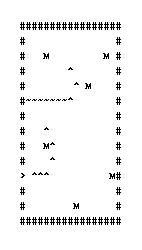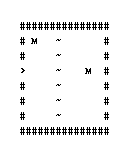Python 2中,3990 3430 4412 4313个字节
这基本上是一个带有丑陋的启发式和丑陋getChildren方法的A * 。要连续运行3个测试用例,需要6.5s在我的计算机上进行。该功能f是这里的解决方案。它以地图为字符串,并以字符串形式返回已求解的地图。
from itertools import*
import sys
from Queue import*
A,B,C,D,E,F,G=">|\\/-MX";H=range;I=permutations;J=set;K=abs;L=len
class M:
@staticmethod
def T(a):return a in">|\\/-MX"
@staticmethod
def C(a,b,c,d,x,y,e):
if not M.T(d)or not M.T(e):return 0
if e in"MX"and d in"MX"and e!=d:return 1
if d==A:return x>0 and(e==D and y==-1 or e==E and y==0 or e==C and y==1)
if d==F:return e==C and K(x+y)==2 or e==D and x+y==0 or e==B and x==0 or e==E and y==0
if d==G:
if b!=0!=c and K(b-x)+K(c-y)==1:return 0
return e==C and K(x+y)==2 or e==D and x+y==0 or e==B and x==0 or e==E and y==0
if e!=""and e in"MX>"and a!=""and a in"MX>":return M.C("",0,0,a,-b,-c,d)and M.C("",0,0,e,-x,-y,d)
elif e!=""and e in"MX>"and a!="":return M.C("",0,0,d,b,c,a)and M.C("",0,0,e,-x,-y,d)
elif e!=""and e in"MX>"and a=="":return M.C("",0,0,e,-x,-y,d)
elif a!=""and a in"MX>":return M.C("",0,0,a,-b,-c,d)and M.C("",0,0,d,x,y,e)
f=[[E,-1,0,E,1,0,E],[D,-1,1,E,1,0,E],[C,-1,-1,E,1,0,E],[E,-1,0,E,1,1,C],[E,-1,0,E,1,-1,D],[C,-1,-1,E,1,-1,D],[D,-1,1,E,1,1,C],[D,-1,1,D,1,-1,D],[D,-1,1,D,1,-1,E],[D,-1,1,D,1,-1,B],[B,-1,1,D,1,-1,D],[E,-1,1,D,1,-1,D],[B,-1,1,D,1,-1,E],[E,-1,1,D,1,-1,B],[C,-1,-1,C,1,1,C],[C,-1,-1,C,1,1,E],[C,-1,-1,C,1,1,B],[B,-1,-1,C,1,1,C],[E,-1,-1,C,1,1,C],[B,-1,-1,C,1,1,E],[E,-1,-1,C,1,1,B],[B,0,-1,B,0,1,B],[C,-1,-1,B,0,1,B],[D,1,-1,B,0,1,B],[B,0,-1,B,-1,1,D],[B,0,-1,B,1,1,C],[D,1,-1,B,1,1,C],[C,-1,-1,B,-1,1,D]];g=0;h=[a,b,c,d,x,y,e];j=[0,3][a==""]
for k in f:
l=1;m=1;n=[k[6],k[4],k[5],k[3],k[1],k[2],k[0]]
for i in H(j,L(k)):
if k[i]!=h[i]:l=0
if n[i]!=h[i]:m=0
if l or m:g=1
return g
def __init__(s,a):s.m=[list(x)for x in a.split("\n")]
def __str__(s):return"\n".join(["".join(x)for x in s.m])
def A(s):return str(s)
def B(s):return L(s.m[0])
def D(s):return L(s.m)
def E(s):
a=[]
for y in H(1,s.D()-1):
for x in H(1,s.B()-1):
if s.J(x,y)==F and L(s.H(x,y, F))==0:a+=[(x,y)]
return a
def F(s):
for y in H(s.D()):
for x in H(s.B()):
if s.J(x,y)==A:return(x,y)
def G(s):
a=0
for y in H(0,s.D()-1):
for x in H(0,s.B()-1):
b=s.J(x,y)
c=L(s.H(x,y,b))
if b==A:
if c==0:a=(x,y)
c=0
if c==1:return(x,y)
if a!=0:
return a
raise ValueError()
def J(s,x,y):return s.m[y][x]
def K(s,x,y,b):
a=[[i for i in row]for row in s.m];a[y][x]=b
return"\n".join("".join(x)for x in a)
def H(s,x,y,c):
d=[];e=[]
for a,b in J(I([-1,-1,0,1,1],2)):
g=s.J(x+a,y+b)
if M.T(g)and M.C("",0,0,c,a,b,g):e+=[[g,a,b]]
if L(e)==1:return[e[0][0]]
if L(e)==0:return[]
for g,h in I(e,2):
i,j,k=g;l,m,n=h;o=x + m;p=y + n
if M.C(i,j,k,c,m,n,l):
if l==F:
if L(s.H(o,p,l))>=1:d+=[l]
else:d+=[l]
return d
def I(s,x,y,a,b):
if a==0 or b==0:return 0
a=s.J(x+a,y);b=s.J(x,y+b)
return(M.T(a)or a==F)and(M.T(b)or b==F)
class P:
@staticmethod
def A(x0,y0,x1,y1):return K(x0-x1)+4*K(y0-y1)
def __init__(s,a,p,t=0,g=0):
s.a=[];s.b=p;s.c=a;s.d=[a];s.e=t;s.f=g
if p:s.d=p.d[:];s.d+=[a];s.e=p.e;s.f=p.f
s.g=M(a);s.h=s.B()
def __str__(s):return s.g.A()
def B(s):
a=0;b=1;c=0
try:c=s.g.G()
except:a=1
d=s.g.E();e=s.g.F();g=[]
if L(d)==0 and not a:g=P.A(c[0],c[1],e[0],e[1])+b
elif L(d)==0 and a:return 0
elif c:
h,i=c
for j in combinations(d,L(d)):
k=0
for x,y in j:k+=P.A(h,i,x,y);h,i=x,y
g+=[k]
g=min(g);g+=s.g.B()+s.g.D()+b
else:return sys.maxint
if g<1:return 0
return g
def C(s):
try:a=s.g.G()
except:s.a=[];return
b=s.g.J(a[0],a[1]);c=("",0,0);e=(0,0)
for x,y in J(I([-1,-1,0,1,1],2)):
g,h=a[0]+x,a[1]+y;i=s.g.J(g,h)
if M.T(i)and M.C("",0,0,i,x,y,b):c=(i,x,y)
if i=="~":e=(x,y)
for x,y in J(I([-1,-1,0,1,1],2)):
g,h=a[0]+x,a[1]+y;i=s.g.J(g,h)
if not(i in"^#"or M.T(i)):
for j in"-|\\/":
if i=="~":
j=G
if c[0]==G:continue
if c[0]==G and K(e[0])==1 and y==c[1]:continue
if c[0]==G and K(e[1])==1 and x==c[0]:continue
k=s.g.H(g,h,j);l=L(k)
if(l==1 or l==2 and A in k)and M.C(c[0],c[1],c[2],b,x,y,j)and not s.g.I(a[0],a[1],x,y):
try:s.a+=[P(s.g.K(g,h,j),s)]
except:pass
def f(x):
d=[];a=[];b=PriorityQueue();b.put((0,P(x,0)))
while not d and b.qsize():
c=b.get()[1];c.C();a+=[c.c]
for e in c.a:
if e.c not in a:
if not e.h:d=e.d
b.put((e.h,e))
return d[-1]
在线尝试!
测试用例
测试1

###########
# ---M #
#/ ^ \ #
> ^^ M #
#\ ^ | #
#~X~~~~X~~#
# M | #
# \ ^^\ #
# -----M#
###########
测试2

#################
# #
# M---------M #
# / ^ / #
# | ^ M- #
#~X~~~~~^ \ #
# | | #
# \^ | #
# --M^ | #
#/ ^- \ #
> ^^^/ \ M#
#\ / \ / #
# -- M---- #
#################
测试3

###############
# M ~ #
#/ \ ~ #
> --X----M #
#\ ~ / #
# ----X--- #
# ~ #
###############
源代码
A *状态+ A *求解器类
我实际上是出于解决方案而打高尔夫球的。但是它们存在于我的“可读”版本中。State类是通用类,可以实现。Solver类采用开始状态,然后跟随该状态进行启发式操作getDist。
from Queue import PriorityQueue
# A* State
class State(object):
# The type of value should be a primative
def __init__(self, value, parent, start=0, goal=0):
self.children = []
self.parent = parent
self.value = value
self.dist = 0
if parent:
self.path = parent.path[:]
self.path.append(value)
self.start = parent.start
self.goal = parent.goal
else:
self.path = [value]
self.start = start
self.goal = goal
# Implement a heuristic for calculating the distance from this state to the goal
def getDist(self):
pass
# Implement a way to create children for this state
def createChildren(self):
pass
# A* Solver
# Note: if maxmin = 1: Solver tries to minimize the distance
# if maxmin = -1: Solver tries to maximize the distance
class AStar_Solver:
def __init__(self,startState,maxmin=1):
self.path = []
self.visitedQueue = []
self.priorityQueue = PriorityQueue()
self.priorityQueue.put((0,startState))
self.startState = startState
self.maxmin = maxmin
self.count = 0
# Create a png of the string 'qPop'
def imager(self,qPop):
# Imager(qPop,str(self.count).rjust(5,"0")+".png")
# print str(qPop)+"\n"
self.count += 1
# Solve the puzzle
def solve(self):
while(not self.path and self.priorityQueue.qsize()):
closestChild = self.priorityQueue.get()[1]
self.imager(str(closestChild))
closestChild.createChildren()
self.visitedQueue.append(closestChild.value)
for child in closestChild.children:
if child.value not in self.visitedQueue:
if not child.dist:
self.imager(str(child))
self.path = child.path
break
self.priorityQueue.put((self.maxmin*child.dist,child))
if not self.path:
print "Goal was not reachable"
return self.path
州级
这是A *状态类的实现。这里最重要的方法是getDist,它是确定离self目标有多接近的启发式方法。从根本上来说,这是访问所有其他目的地并重新开始的最小距离。
from A_Star import State,AStar_Solver
from Ruby_Map import Map
from itertools import combinations, permutations
import sys
# A state class designed to work with A*
class State_Pathfinder(State):
# This is deprecated
@staticmethod
def toValue(location):
return str(location[0])+","+str(location[1])
# Calculate the weighted distance between 2 points.
# Not sure why the deltaY is more weighted. My theory
# is that it is because the starting point is always
# on a side. So vertical space is most precious?
@staticmethod
def distance(x0,y0,x1,y1):
# return (abs(x0-x1)**2+abs(y0-y1)**2)**.5
return 1*abs(x0-x1)+4*abs(y0-y1)
def __init__(self, maps, parent, value=0, start=0, goal=0):
super(State_Pathfinder,self).__init__(maps,parent,start,goal)
self.map = Map(maps)
self.dist = self.getDist()
if not value:
location = self.map.getLocation()
self.value = maps
self.path = [self.value]
def __str__(self):
return self.map.getDisplay()
# The heuristic function that tells us
# how far we are from the goal
def getDist(self):
blownup = False
WEIGHT = 1
location = None
try:
location = self.map.getLocation()
except ValueError as e:
blownup = True
destinations = self.map.getDestinations()
goal = self.map.getGoal()
dist = []
if len(destinations) == 0 and not blownup:
dist = State_Pathfinder.distance(location[0],location[1],goal[0],goal[1])+WEIGHT
elif len(destinations) == 0 and blownup:
return 0
elif location:
oldX,oldY = location
for path in combinations(destinations,len(destinations)):
length = 0
for pair in path:
x,y = pair
length += State_Pathfinder.distance(oldX,oldY,x,y)
oldX,oldY = x,y
dist.append(length)
dist = min(dist)
dist += self.map.getWidth()+self.map.getHeight()+WEIGHT
else:
return sys.maxint
if dist<1:
return 0
return dist
# Creates all possible (legal) child states of this state
def createChildren(self):
if not self.children:
try:
location = self.map.getLocation()
except:
self.children = []
return
track = self.map.get(location[0],location[1])
intrack = ("",0,0)
river = (0,0)
for x,y in set(permutations([-1,-1,0,1,1],2)):
realX,realY = location[0]+x,location[1]+y
adjacent = self.map.get(realX,realY)
if Map.isTrack(adjacent) and Map.isConnected("",0,0,adjacent,x,y,track):
intrack = (adjacent,x,y)
if adjacent=="~":
river = (x,y)
for x,y in set(permutations([-1,-1,0,1,1],2)):
realX,realY = location[0]+x,location[1]+y
adjacent = self.map.get(realX,realY)
if not Map.isBlocking(adjacent) and not adjacent in "M":
for outtrack in "-|\\/":
if adjacent=="~":
outtrack="X"
if intrack[0]=="X":continue
if intrack[0]=="X" and abs(river[0])==1 and y==intrack[1]:continue
if intrack[0]=="X" and abs(river[1])==1 and x==intrack[0]:continue
connections = self.map.getConnections(realX,realY,outtrack)
hoppin = len(connections)
connected = Map.isConnected(intrack[0],intrack[1],intrack[2],track,x,y,outtrack)
blocked = self.map.isBlocked(location[0],location[1],x,y)
if (hoppin==1 or hoppin==2 and ">" in connections) and connected and not blocked:
try:
maps = self.map.set(realX,realY,outtrack)
value = State_Pathfinder.toValue((realX,realY))
child = State_Pathfinder(maps,self,value)
self.children.append(child)
except ValueError as e:
print "Bad kid"
print e
# The solution function. Takes a map string
# and returns a map string.
def f(mapX):
a = AStar_Solver(State_Pathfinder(mapX,0))
a.solve()
print a.path[-1]
if __name__ == "__main__":
map1 = """###########
# M #
# ^ #
> ^^ M #
# ^ #
#~~~~~~~~~#
# M #
# ^^ #
# M#
###########"""
map2 = """#################
# #
# M M #
# ^ #
# ^ M #
#~~~~~~~^ #
# #
# ^ #
# M^ #
# ^ #
> ^^^ M#
# #
# M #
#################"""
map3 = """###############
# M ~ #
# ~ #
> ~ M #
# ~ #
# ~ #
# ~ #
###############"""
f(map3)
f(map2)
f(map1)
地图类
此类存储和处理地图。该isConnected方法可能是最重要的部分。它进行测试以查看是否连接了2条轨道。
from itertools import permutations,combinations
# A map class designed to hold string map
# the specification is found here:
# http://codegolf.stackexchange.com/questions/104965/ruby-on-rails-or-trackety-track
class Map(object):
# Is 'track' part of the railroad?
@staticmethod
def isTrack(track):
return track in ">|\\/-MX"
# Can I not build on this terrian?
@staticmethod
def isBlocking(terrian):
return terrian in "^#" or (Map.isTrack(terrian) and not terrian=="M")
# Are these 3 consecuative tracks connected in a legal fashion?
@staticmethod
def isConnected(inTerrian,relativeXin,relativeYin,centerTerrian,relativeXout,relativeYout,outTerrian):
tin = inTerrian
xin = relativeXin
yin = relativeYin
x = relativeXout
y = relativeYout
tout = outTerrian
center = centerTerrian
if not Map.isTrack(center) or not Map.isTrack(tout):
return False
if tout in "MX" and center in "MX" and tout!=center:
return True
if center == ">":
return x>0 and (\
tout == "/" and y == -1 or \
tout == "-" and y == 0 or \
tout == "\\" and y == 1 \
)
if center == "M":
return tout == "\\" and abs(x+y) == 2 or \
tout == "/" and x+y == 0 or \
tout == "|" and x == 0 or \
tout == "-" and y == 0
if center == "X":
if xin!=0!=yin and abs(xin-x)+abs(yin-y) == 1:
return False
return tout == "\\" and abs(x+y) == 2 or \
tout == "/" and x+y == 0 or \
tout == "|" and x == 0 or \
tout == "-" and y == 0
if tout!="" and tout in "MX>" and tin!="" and tin in "MX>":
return Map.isConnected("",0,0,tin,-xin,-yin,center) and Map.isConnected("",0,0,tout,-x,-y,center)
elif tout!="" and tout in "MX>" and tin!="":
return Map.isConnected("",0,0,center,xin,yin,tin) and Map.isConnected("",0,0,tout,-x,-y,center)
elif tout!="" and tout in "MX>" and tin=="":
return Map.isConnected("",0,0,tout,-x,-y,center)
elif tin!="" and tin in "MX>":
return Map.isConnected("",0,0,tin,-xin,-yin,center) and Map.isConnected("",0,0,center,x,y,tout)
allowed = [ \
["-",-1,0,"-",1,0,"-"], \
["/",-1,1,"-",1,0,"-"], \
["\\",-1,-1,"-",1,0,"-"], \
["-",-1,0,"-",1,1,"\\"], \
["-",-1,0,"-",1,-1,"/"], \
["\\",-1,-1,"-",1,-1,"/"], \
["/",-1,1,"-",1,1,"\\"], \
["/",-1,1,"/",1,-1,"/"], \
["/",-1,1,"/",1,-1,"-"], \
["/",-1,1,"/",1,-1,"|"], \
["|",-1,1,"/",1,-1,"/"], \
["-",-1,1,"/",1,-1,"/"], \
["|",-1,1,"/",1,-1,"-"], \
["-",-1,1,"/",1,-1,"|"], \
["\\",-1,-1,"\\",1,1,"\\"], \
["\\",-1,-1,"\\",1,1,"-"], \
["\\",-1,-1,"\\",1,1,"|"], \
["|",-1,-1,"\\",1,1,"\\"], \
["-",-1,-1,"\\",1,1,"\\"], \
["|",-1,-1,"\\",1,1,"-"], \
["-",-1,-1,"\\",1,1,"|"], \
["|",0,-1,"|",0,1,"|"], \
["\\",-1,-1,"|",0,1,"|"], \
["/",1,-1,"|",0,1,"|"], \
["|",0,-1,"|",-1,1,"/"], \
["|",0,-1,"|",1,1,"\\"], \
["/",1,-1,"|",1,1,"\\"], \
["\\",-1,-1,"|",-1,1,"/"] \
]
passing = False
forward = [tin,xin,yin,center,x,y,tout]
start = [0,3][tin==""]
for allow in allowed:
maybeF = True
maybeB = True
backallowed = [allow[6],allow[4],allow[5],allow[3],allow[1],allow[2],allow[0]]
for i in range(start,len(allow)):
if allow[i]!=forward[i] and str(forward[i])not in"*":
maybeF = False
if backallowed[i]!=forward[i] and str(forward[i])not in"*":
maybeB = False
if maybeF or maybeB:
passing = True
return passing
def __init__(self,mapString):
self.indexableMap = [list(x) for x in mapString.split("\n")]
def __str__(self):
return "\n".join(["".join(x) for x in self.indexableMap])
# Get the string representation of this map
def getDisplay(self):
return self.__str__()
# Get map width
def getWidth(self):
return len(self.indexableMap[0])
# Get map height
def getHeight(self):
return len(self.indexableMap)
# Get unvisited destinations
def getDestinations(self):
destinations = []
for y in xrange(1,self.getHeight()-1):
for x in xrange(1,self.getWidth()-1):
sigma = 2
if self.get(x,y)=="M":
sigma = len(self.getConnections(x,y,"M"))
if sigma==0:
destinations.append((x,y))
return destinations
# Get the x,y of the goal (endpoint)
def getGoal(self):
for y in xrange(self.getHeight()):
for x in xrange(self.getWidth()):
if self.get(x,y)==">":
return (x,y)
# Get the x,y of the current location
def getLocation(self):
location = None
for y in xrange(0,self.getHeight()-1):
for x in xrange(0,self.getWidth()-1):
track = self.get(x,y)
sigma = len(self.getConnections(x,y,track))
if track == ">":
if sigma==0:
location = (x,y)
sigma = 0
if sigma == 1:
return (x,y)
if location != None:
return location
raise ValueError('No location found in map\n'+self.getDisplay())
# Get the terrian at x,y
def get(self,x,y):
return self.indexableMap[y][x]
# Set the terrain at x,y
# (non-destructive)
def set(self,x,y,value):
newMap = [[i for i in row] for row in self.indexableMap]
newMap[y][x] = value
return "\n".join(["".join(x) for x in newMap])
# Get the track connectioning to a piece of track at x,y
def getConnections(self,x,y,track):
connections = []
tracks = []
for a,b in set(permutations([-1,-1,0,1,1],2)):
outtrack = self.get(x+a,y+b)
if Map.isTrack(outtrack) and Map.isConnected("",0,0,track,a,b,outtrack):
tracks+=[[outtrack,a,b]]
if len(tracks)==1:return [tracks[0][0]]
if len(tracks)==0:return []
for inner,outer in permutations(tracks,2):
intrack,relXin,relYin = inner
other,relX,relY = outer
ex = x + relX
ey = y + relY
if Map.isConnected(intrack,relXin,relYin,track,relX,relY,other):
if other == "M":
if len(self.getConnections(ex,ey,other))>=1:
connections.append(other)
else:
connections.append(other)
return connections
# Is could a piece of track at x,y build in
# the direct of relX,relY?
def isBlocked(self,x,y,relX,relY):
if relX==0 or relY==0:
return False
side1 = self.get(x+relX,y)
side2 = self.get(x,y+relY)
return (Map.isTrack(side1) or side1=="M") and (Map.isTrack(side2) or side2=="M")
更新
- -560 [17-03-31]一堆基本的正则表达式高尔夫
- +982 [17-03-31]修复了非法铺设轨道的问题。谢谢@ fəˈnɛtɪk!
- -99 [17-03-31]已使用
;s


